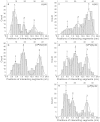Mechanism of amyloid β-protein dimerization determined using single-molecule AFM force spectroscopy
- PMID: 24096987
- PMCID: PMC3791449
- DOI: 10.1038/srep02880
Mechanism of amyloid β-protein dimerization determined using single-molecule AFM force spectroscopy
Abstract
Aβ42 and Aβ40 are the two primary alloforms of human amyloid β-protein (Aβ). The two additional C-terminal residues of Aβ42 result in elevated neurotoxicity compared with Aβ40, but the molecular mechanism underlying this effect remains unclear. Here, we used single-molecule force microscopy to characterize interpeptide interactions for Aβ42 and Aβ40 and corresponding mutants. We discovered a dramatic difference in the interaction patterns of Aβ42 and Aβ40 monomers within dimers. Although the sequence difference between the two peptides is at the C-termini, the N-terminal segment plays a key role in the peptide interaction in the dimers. This is an unexpected finding as N-terminal was considered as disordered segment with no effect on the Aβ peptide aggregation. These novel properties of Aβ proteins suggests that the stabilization of N-terminal interactions is a switch in redirecting of amyloids form the neurotoxic aggregation pathway, opening a novel avenue for the disease preventions and treatments.
Figures





Similar articles
-
Effects of the Arctic (E22-->G) mutation on amyloid beta-protein folding: discrete molecular dynamics study.J Am Chem Soc. 2008 Dec 24;130(51):17413-22. doi: 10.1021/ja804984h. J Am Chem Soc. 2008. PMID: 19053400
-
Nanoprobing of misfolding and interactions of amyloid β 42 protein.Nanomedicine. 2014 May;10(4):871-8. doi: 10.1016/j.nano.2013.11.016. Epub 2013 Dec 10. Nanomedicine. 2014. PMID: 24333588 Free PMC article.
-
The structures of the E22Δ mutant-type amyloid-β alloforms and the impact of E22Δ mutation on the structures of the wild-type amyloid-β alloforms.ACS Chem Neurosci. 2013 Feb 20;4(2):310-20. doi: 10.1021/cn300149j. Epub 2012 Dec 18. ACS Chem Neurosci. 2013. PMID: 23421682 Free PMC article.
-
Role of the region 23-28 in Abeta fibril formation: insights from simulations of the monomers and dimers of Alzheimer's peptides Abeta40 and Abeta42.Curr Alzheimer Res. 2008 Jun;5(3):244-50. doi: 10.2174/156720508784533330. Curr Alzheimer Res. 2008. PMID: 18537541 Review.
-
Aβ42 and Aβ40: similarities and differences.J Pept Sci. 2015 Jul;21(7):522-9. doi: 10.1002/psc.2789. Epub 2015 May 28. J Pept Sci. 2015. PMID: 26018760 Review.
Cited by
-
Probing Changes in Ca2+-Induced Interaction Forces between Calmodulin and Melittin by Atomic Force Microscopy.Micromachines (Basel). 2020 Sep 30;11(10):906. doi: 10.3390/mi11100906. Micromachines (Basel). 2020. PMID: 33007824 Free PMC article.
-
Seeding and Growth of β-Amyloid Aggregates upon Interaction with Neuronal Cell Membranes.Int J Mol Sci. 2020 Jul 16;21(14):5035. doi: 10.3390/ijms21145035. Int J Mol Sci. 2020. PMID: 32708806 Free PMC article.
-
Self-assembly of the full-length amyloid Aβ42 protein in dimers.Nanoscale. 2016 Dec 7;8(45):18928-18937. doi: 10.1039/c6nr06850b. Epub 2016 Oct 6. Nanoscale. 2016. PMID: 27714140 Free PMC article.
-
The Role of Structural Polymorphism in Driving the Mechanical Performance of the Alzheimer's Beta Amyloid Fibrils.Front Bioeng Biotechnol. 2019 Apr 24;7:83. doi: 10.3389/fbioe.2019.00083. eCollection 2019. Front Bioeng Biotechnol. 2019. PMID: 31106199 Free PMC article.
-
Force clamp approach for characterization of nano-assembly in amyloid beta 42 dimer.Nanoscale. 2019 Jul 7;11(25):12259-12265. doi: 10.1039/c9nr01670h. Epub 2019 Jun 18. Nanoscale. 2019. PMID: 31210224 Free PMC article.
References
-
- Chiti F. & Dobson C. M. Protein misfolding, functional amyloid, and human disease. Annu Rev Biochem 75, 333–366 (2006). - PubMed
-
- Benilova I., Karran E. & De Strooper B. The toxic Abeta oligomer and Alzheimer's disease: an emperor in need of clothes. Nat Neurosci 15, 349–357 (2012). - PubMed
-
- Karran E., Mercken M. & De Strooper B. The amyloid cascade hypothesis for Alzheimer's disease: an appraisal for the development of therapeutics. Nat Rev Drug Discov 10, 698–712 (2011). - PubMed
Publication types
MeSH terms
Substances
Grants and funding
LinkOut - more resources
Full Text Sources
Other Literature Sources
Miscellaneous

